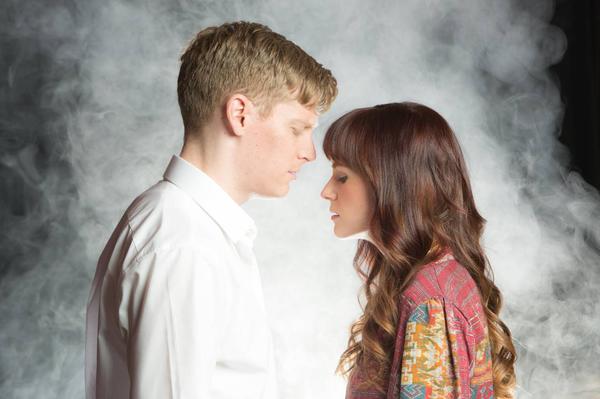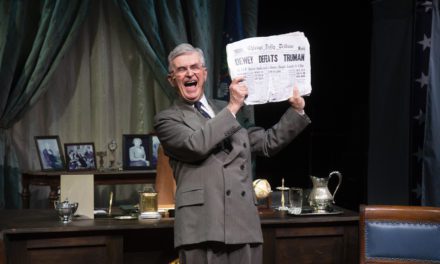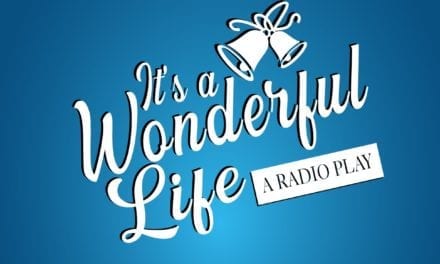WEST VALLEY CITY — Based on the 1990 Oscar Award winning romantic drama film, starring Patrick Swazye, Demi Moore, and Whoopi Goldberg, Ghost the Musical is fresh off of Broadway in its first Utah production at Hale Centre Theatre in West Valley. With a book and lyrics by Bruce Joel Rubin and music and lyrics by Dave Stewart and Glen Ballard, continues a trend on Broadway of adapting widely successful blockbuster films into large-scale musicals (such as Catch Me If You Can, 9 to 5, and The Bridges of Madison County). Hale Centre Theatre has also continued this trend with Ghost by bringing these movie-to-musical adaptations to Utah, which they have done for the past few seasons.
The plot centers on lovers Sam Wheat (played by Keith McKay Evans), an up-and coming-banker, and Molly Jensen (Bre Welch), an artist and sculptor, who are attacked as they are returning to their apartment after a date. When Sam dies, he becomes caught between the real world and the next. In realizing that Molly is in danger, Sam cannot leave her so he stays behind. A medium, Oda Mae Brown (McKenna Jensen), helps Sam to get in touch with Molly to warn her. Sam learns that his friend and co-worker Carl Bruner (Kris Paries) hired Willie Lopez (Carlos A. Garcia), to steal his wallet in order to gain a code needed in a money laundering scheme. Unfortunately, Lopez ended up shooting Sam in the process. Now Sam must stop Carl’s scheme that he lost his life for and protect Molly. During this quest, Sam learns from a Subway Ghost (Ames Bell) how to move objects and interact with people in the real world.
Like so many of these movie to musical adaptations, Ghost’s script lacks character and plot development. Other than a few standout musical numbers, the music was uninteresting and composed of a largely forgettable score. Hale had an uphill battle to overcome with these inherent weaknesses. The Broadway production (which I had the opportunity to see) overcame such challenges through the use of illusions in creating life after death with characters becoming ghosts upon their death and walking through walls. This level of spectacle added an impressive element to the production that was crucial to the production’s success. I was disappointed that Hale (who has previously been known to execute impressive special effects in their productions of Mary Poppins, Chitty Chitty Bang Bang, and Tarzan) did not attempt to incorporate this important element to their production, which I had incorrectly assumed was one of their driving forces in selecting the production for their season.
The next fundamental problem with this production is that Ghost is a passionate love story between Sam and Molly. Sex, murder, and violence are all key parts of the storytelling that are not necessarily appropriate for a “family friendly” audience that the Hale caters to. Hale’s attempts to censor or remove these important layers of the story left a lifeless shell of a production and kept me from becoming emotionally invested in any of the characters or the love story. For example, the conservative costuming (under the design of Tamara Baker) was certainly not New York—more like Utah County—and that took the sexy edge from Molly’s character. The passion in the relationship between Molly and Sam was largely lost. The romantic scene on the couch of their new apartment during the song “Unchained Melody” came across more as an awkward BYU first date than two lovers madly in love moving into their first apartment together. This much-needed passion is crucial in fueling the entire story, and I just never felt it between Evan or Welch’s performances.
Kris Paries played the cunning friend Carl in a convincing manner, but he too did not take the moral reprehensible behavior far enough. The scene where he starts to become sexually attracted to Molly (despite her unrevealing attire) and intentionally spills coffee on his shirt to remove it as a tactic to move in on a vulnerable, grief-stricken Molly fell flat. Instead the decision was made for Carl to leave the room and change shirts as to steer away from an edgy scene and completely miss the playwrights’s intended plot point. And Willie Lopez’s self-stimulation scene with Molly’s picture in bed was also removed. All of these censors neutered the production, creating shallow and lifeless characters that were largely uninteresting and void of honest human passion and grit.
As Oda Mae Brown, Jensen was the definite comedic relief of the production and for the most part delivered. However, some of the comedy was missed, and her song “Are You a Believer?” was not as energized as I would have liked. It felt as if she was holding back a bit and the number never really soared as this show-stopper should. Yet, Jensen had the sass and attitude of the character down correctly. Her interactions with Sam were especially entertaining as their two cultures clashed. Her visit to the bank as “Rita Miller” was absolutely hilarious in her attempts to portray an upscale woman of class (though failing miserably).
Kelly Dehaan did an excellent job musically with the production. I was impressed to see a live piano and several string instruments that supplemented the recorded tracks, which added a nice element to the production. Evans had a gorgeous voice and handled the score with appropriate pop stylizing and singing the high tenor notes with ease. Yet, he was miscast in this role, as he did not have the masculine or rugged edge that the part required. Making his learning to express his love to Mollie and say, “I love you” rather than “ditto” an unconvincing journey. Welch also had an incredible voice and handled the complex score with ease and her voice excelled during such number as “Here Right Now” and “Nothing Stops another Day.” However, Welch too was miscast; she lacked the artistic flair and sex appeal that are so needed in the role. However, the closing number of Act One “Suspend My Disbelief/I Had a Life” montage sequence was especially powerful and Evans, Welch and Paries’s voices blended well and brought the emotional stakes of the show to a powerful climax that I wanted for the rest of the production.
Director Chris Clark utilized the space effectively to keep the story moving and to create a variety of locations in interesting ways. The set (under the design Kacey Udy) was well designed and functional in creating a variety of levels and locations. However, it didn’t capture the feeling of New York City. A lack of northeastern accents and attitudes made the group numbers unclear and the individual ensemble members ambiguous in their character creation.
The lighting (under the design of Adam Flitton) and sound (under the design of Shane Steel and Dan Morgan) designs were impressively created and the strongest elements of the production. Both designs added a level of intensity to the production, particularly during the death sequences and establishing life after death with eerie sounds and dramatic lighting. The death of Carl and Willie and accompanying fight scenes with Sam were effectively aided with such strong designs to create the supernatural and clarity in storytelling.
With the lack of heart and passion, a weak book made weaker through edits, a forgettable score, miscast leads, and missing illusions, fans of the movie and Broadway production will be left disappointed and at times bored with Hale’s production of Ghost the Musical. I recommend passing on this one and wait for Hale’s next production which is clearly more in line with their mission statement. I have full confidence will deliver.







